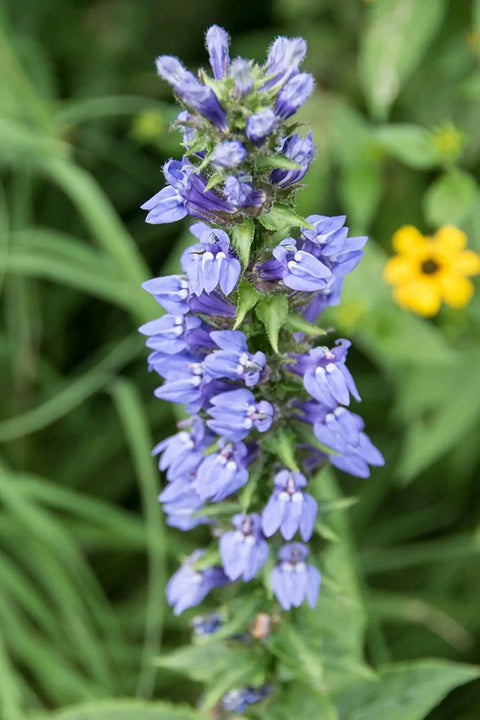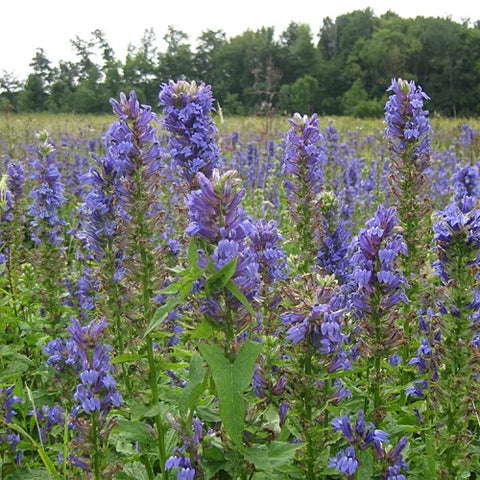

Blue Lobelia: A Stunning Addition to Gardens and Landscapes
Blue Lobelia is a charming and all-around flowering plant that has captured the hearts of gardeners and landscapers alike. Known for its blue or purple flowers, this perennial plant is a favorite for adding color to garden beds, hanging baskets, and other things that relate to gardening. Blue Lobelia is an excellent choice for creating a picturesque outdoor space, whether you are a novice gardener or a seasoned horticulturist.
Native to Southern Africa, Blue Lobelia belongs to the Lobeliaceae family, which includes over 400 species of plants. The most commonly cultivated species, Lobelia erinus, is renowned for its brilliant blue flowers that appear in late spring through summer. These small, funnel-shaped blooms grow in clusters and are often accented by delicate, lobed leaves that form a low-growing, spreading mound. In addition to blue, you may find Lobelia in shades of purple, white, and pink, though the blue varieties remain the most popular.
Growing Conditions for Great Blue Lobelia
Blue Lobelia is relatively easy to grow, making it an excellent choice for gardeners at any experience level. Here are the key factors to consider when planting:
- Sunlight: Lobelia thrives in full sun to partial shade. While it prefers at least 4-6 hours of direct sunlight per day, it can tolerate some shade, particularly in warmer climates where afternoon sun can become too intense.
- Soil: A well-draining, moist soil is crucial for Lobelia's health. The plant is not fond of dry conditions and will do poorly if the soil becomes too dry or compacted.
- Watering: Regular watering is essential for Blue Lobelia. The plant does not like to dry out completely, so aim to keep the soil consistently moist but not soggy. Be sure the soil drains well to avoid root rot, which can be a concern if the plant is overwatered.
- Temperature: Lobelia is hardy in USDA zones 10-11, but it is often grown annually in colder climates. It is sensitive to frost and should be planted only after the last frost in spring to ensure healthy growth.
Care and Maintenance for blue lobelia
Blue Lobelia is relatively low-maintenance but does benefit from a few care practices to ensure it flourishes:
- Deadheading: Regularly removing spent flowers (deadheading) encourages the plant to produce new blooms. This simple task will help extend the flowering period and keep the plant tidy.
- Pruning: If the plant becomes leggy or overgrown, pruning it back can help rejuvenate the growth and promote denser, more compact foliage. Trimming can also help the plant maintain a bushier appearance, particularly in hanging baskets or container gardens.
- Fertilizing: Blue Lobelia benefits from light feeding with a good, balanced fertilizer every few weeks during the growing season. Too much fertilizer can result in too much foliage growth at the expense of flowers, so moderation is key.
Pest and Disease Resistance
While Blue Lobelia is generally pest-resistant, it may occasionally attract aphids, slugs, or snails. These pests can be controlled through natural remedies such as neem oil or by introducing beneficial insects like ladybugs.
Regarding diseases, Lobelia is susceptible to fungal infections such as powdery mildew, especially if air circulation is poor or the plant is overwatered. To prevent this, make sure the plant can drain adequately and has overhead watering.
Landscaping with Blue Lobelia
- Garden Borders: Blue Lobelia is a low-growing ground cover perfect for edging garden paths, flower beds, or vegetable gardens. It goes beautifully with other perennials and annuals, particularly those with contrasting flower colors.
- Mixed Plantings: Lobelia can be combined with plants that grow similar, such as pansies, petunias, or violas, for a colorful, unified display.
Season:
Summer, Fall
Zone:
4-9
Exposure:
Full Sun
Deer Resistant:
Yes
Native:
Yes



